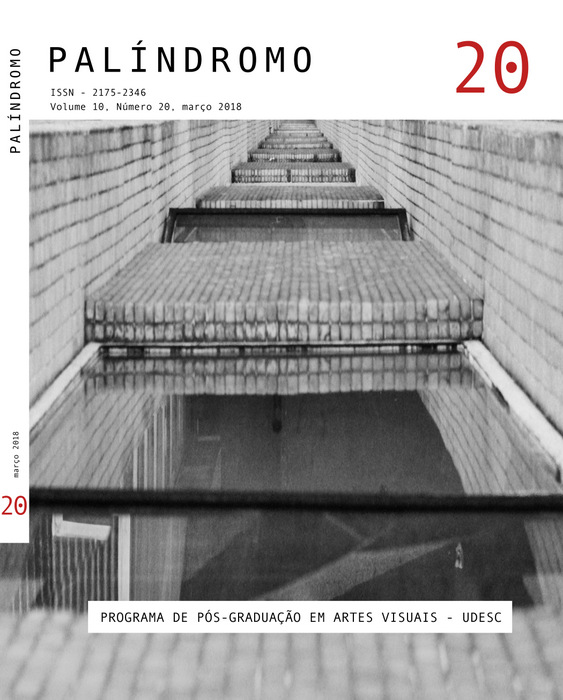Corpo, cidade e política na poética do coletivo Opavivará!
DOI:
https://doi.org/10.5965/2175234609202018113Palabras clave:
política da estética, coletivos, corpo, Opavivará!Resumen
Este artigo se destina a pensar possíveis entrelaçamentos entre política, corpo e cidade, no âmbito da poética do coletivo carioca Opavivará! Inicialmente apresentamos algumas relações entre os poderes que atuam na conformação do espaço urbano e produção de subjetividades, explicitando de que forma a experiência urbana contemporânea dificulta os processos de singularização. Em seguida pontuamos de que maneira os coletivos podem assumir os vultos de importantes sujeitos políticos no contemporâneo, para então analisarmos alguns trabalhos do coletivo supracitado.
Descargas
Citas
BARTHES, R. Aula: aula inaugural da Cadeira de Semiologia Literária do Colégio de França. São Paulo: Cultrix, 2013.
______Como viver junto: simulações romanescas de alguns espaços cotidianos. São Paulo: Martins Fontes, 2013.
BENJAMIN, W. Obras Escolhidas III: Charles Baudelaire - Um lírico no auge do Capitalismo. São Paulo: Editora Brasiliense, 1991.
______ A modernidade e os modernos. Rio de Janeiro: Tempo Brasileiro, 2000.BEY, H. Taz: Zona Autônoma Temporária. São Paulo: Conrad, 2004.
BIDOU-ZACHARIASEN, C. (org.). De volta à cidade: dos processos de gentrificação às políticas de “revitalização” dos centros urbanos. São Paulo: Annablume, 2006.
BOURRIAUD, N. Estética Relacional. São Paulo: Martins Fontes, 2009.
CERTEAU, M. A invenção do cotidiano I: as artes do fazer. Petrópolis: Vozes, 1994. FOUCAULT, M. Microfísica do Poder. Rio de Janeiro: Graal, 1989.
O sujeito e o poder. In: DREYFUS, Hubert & RABINOW, Paul. Michel Foucault, Uma trajetória filosófica: para além do estruturalismo e da hermenêutica. Rio de Janeiro: Forense Universitária, 1995.
______ Em defesa da sociedade: Curso dado no Collège de France (1975-1976). São Paulo: Martins Fontes, 1999.
______ Segurança, território, população: Curso dado no Collège de France (1977-1978). São Paulo: Martins Fontes, 2008.
______ Vigiar e punir: nascimento da prisão. Petrópolis: Vozes, 2009.
GUATTARI, F. Caosmose: um novo paradigma estético. Rio de Janeiro: Editora 34, 1992.
HARDT, M. & NEGRI, A. Multidão: Guerra e democracia na era do Império. Rio de Janeiro: Record, 2005.
MIGLIORIN, C. O que é um coletivo? In: BRASIL, André. Teia 2002-2012. Belo Horizonte: Teia, 2012.
PÉLBART, P. P. Elementos para uma cartografia da grupalidade. In: SAADI, F. & GARCIA, S. (Org.). Próximo ato: questões da teatralidade contemporânea. São Paulo: Itaú Cultural, 2008.
RANCIÈRE, J. O Desentendimento: política e filosofia. São Paulo: Ed. 34, 1996.
______ A partilha do sensível. São Paulo: Editora 34, 2009.REZENDE, R. & SCOVINO, F. Coletivos. Rio de Janeiro: Editora Circuito, 2010.
ROLNIK, S. “Geopolítica da cafetinagem”. In: SCHÜLER, Fernando & AXT, Gunter (orgs.). Brasil contemporâneo. Crônicas de um país incógnito. Porto Alegre: Artes e ofícios, 2006.
SILVEIRA, C. B. “Projetos urbanos culturais na cidade do Rio de Janeiro”. In: JEUDY, J. P. & JACQUES, P. B. (orgs.). Corpos e cenários urbanos. Salvador: EDUFBA.
TURNER, V. Dramas, campos e metáforas: ação simbólica na sociedade humana. Niteroi: EdUFF, 2008.
Descargas
Publicado
Cómo citar
Número
Sección
Licencia
Derechos de autor 2018 Palíndromo

Esta obra está bajo una licencia internacional Creative Commons Atribución 4.0.
DECLARAÇÃO DE DIREITOS AUTORAIS
a. Os artigos publicados pela revista são de uso gratuito, destinados a aplicações acadêmicas e não comerciais. Todos os direitos autorais são atribuídos à revista. Os artigos cujos autores são identificados representam a expressão do ponto de vista de seus autores e não a posição oficial da Revista Palíndromo. O (s) autor (es) compromete-se sempre que publicar material referente ao artigo publicado no Palíndromo mencionar esta publicação da seguinte forma:
Este artigo foi publicado originalmente pela revista Palíndromo em seu volume (coloque o volume), número (coloque o número) no ano de (coloque o ano) e pode ser acessado em: http://www.revistas.udesc.br/index.php/palindromo
b. Plágio, em todas as suas formas, constitui um comportamento antiético de publicação e é inaceitável. A revista Palíndromo utiliza o software iThenticate de controle de similaridade


